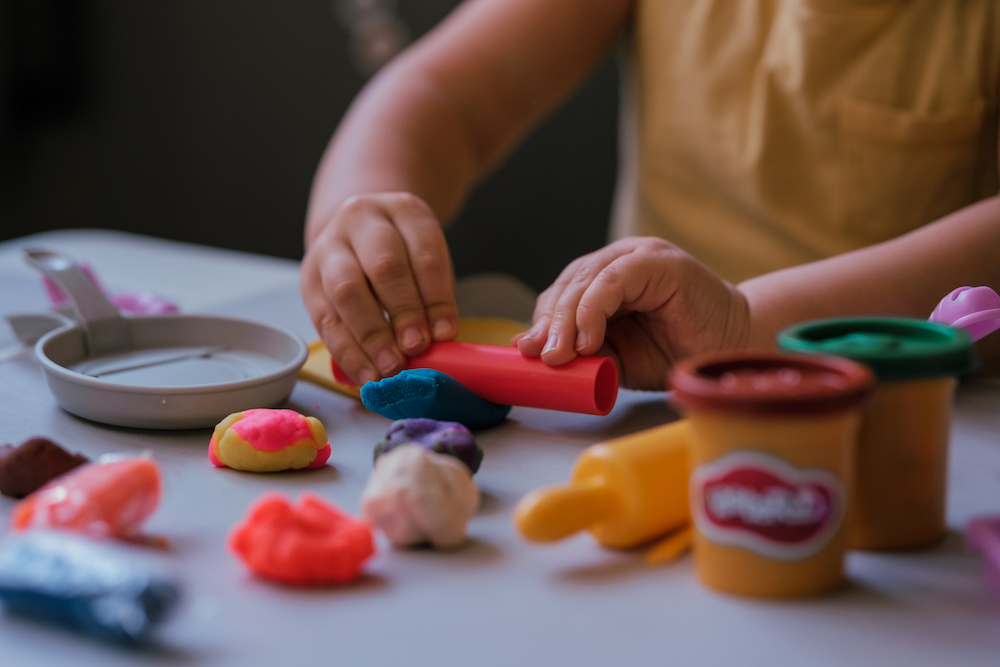A Problematic Coping Strategy
It is not uncommon for parents to rely on digital devices as a quick fix for fussy behavior in their preschooler — particularly if they are trying to get dinner on the table, take a phone call, or run an errand. If you are in a grocery store for any length of time, you most likely will see this approach in action. But a recent study published in JAMA Pediatrics may give us pause for thought about this coping strategy. The researchers found that frequent use of tablets and smartphones to calm young children was associated with “increased emotional dysregulation in kids, particularly in boys.”2
Let’s have a closer look at the research and explore positive alternatives to addressing challenging behavior in young children.
Behavior, Devices, and Young Children
A study at the University of Michigan C.S. Mott Children’s Hospital found that when young children were given a smartphone or tablet as a calming tool, it led to increased behavioral and emotional dysregulation over a six-month period.1 This included “rapid shifts between sadness and excitement, a sudden change in mood or feelings and heightened impulsivity.” The study involved 422 parents and 422 children ages 3-5 who participated in the evaluation August 2018 through January 2020.
The team discovered that these consequences were especially pronounced in young boys and those who already struggle with hyperactivity, impulsiveness, and strong temperament, making them much more likely to experience intense emotions such as anger, frustration, and sadness.
“Using mobile devices to settle down a young child may seem like a harmless, temporary tool to reduce stress in the household, but there may be long term consequences if it’s a regular go-to soothing strategy,” said lead author Jenny Radesky, M.D. “Particularly in early childhood, devices may displace opportunities for development of independent and alternative methods to self-regulate.”2

Positive Methods for Addressing Disruptive Behavior
Radesky, who is a mother herself, recognizes there are times when parents may use devices strategically to distract children in specific circumstances, such as while traveling or multitasking with work. She doesn’t see an issue with the occasional use of devices for this purpose. However, when it becomes a primary tool for soothing the child, it can set the stage for a problematic cycle of emotional dysregulation. Instead, she suggests the following alternatives:
Sensory Engagement: Young children have a unique preference for what type of sensory input is calming for them. Some enjoy swinging, hugs, or pressure such as a firm shoulder massage. While others prefer jumping, squeezing a stress ball or playdough, listening to music, reading books, or looking at a sparkle jar. Picking up on early cues that the child is becoming fidgety or bored, and then redirecting them to the sensory activity of their choice is exceedingly helpful in deflecting meltdowns or poor behavior.
Naming Emotions: When parents stay calm and name the emotion the child is feeling, it signals to the child that they are understood and assists them in connecting language to their feeling state. It also helps to make big emotions more manageable for the child.
Color Zones: Parents of young children realize that it is difficult for them to grasp the abstract concepts of emotions. This is why creating and using “color zones” can help the child to understand their feelings on their level. Blue for bored, green for calm, yellow for anxious/agitated, and red for anger can be made into a visual guide that is placed on the refrigerator to help your little ones paint a mental picture of how they are feeling. Radesky suggests parents can then use these color zones in challenging circumstances, such as “you are getting wiggly and in the yellow zone — what can you do to get back to green?”2
Substitute Behaviors: I think most parents can agree that when your child is acting out, you just want it to stop. But if we can stay calm and recognize that the behavior is communicating emotions, we can teach them a substitute behavior that is safer and more productive. Radesky provides a few examples, such as “hitting hurts people, you can hit this pillow instead” or “if you want my attention, just tap my arm and say ‘excuse me, mom'”.
“All of these solutions help children understand themselves better, and feel more competent at managing their feelings,” Radesky said. “It takes repetition by a caregiver who also needs to try to stay calm and not overreact to the child’s emotions, but it helps build emotion regulation skills that last a lifetime.
In contrast, using a distractor like a mobile device doesn’t teach a skill — it just distracts the child away from how they are feeling. Kids who don’t build these skills in early childhood are more likely to struggle when stressed out in school or with peers as they get older.”2

The Power of Nature
Another idea to consider is that nature deficit disorder is increasingly common not only among children, but also adults. In our modern lives, we tend to spend an inordinate amount of time indoors in front of the television or on our devices instead of out in nature. This, I believe, is a crucial mistake. It often contributes to outbursts and poor behavior from our children, while in adults it can lead to anxiety, depression, and angry moods. It also increases stress, which contributes to lowered immunity and negatively impacts the microbiome, which in turn can suppress the production of feel-good neurotransmitters.
Handing a child exhibiting challenging behavior a device to distract them will only exacerbate the problem long-term. Instead, make sure you and your family are getting plenty of time out in nature. This could be anything from a backyard garden to an urban park as well as a forest, seaside, or lake.
Interestingly, a movement was started years ago in Germany to create “forest schools” for young children where a good chunk of their day was spent outdoors — rain, shine, or snow. This idea has taken root across the US as well with exceptional results. The kids are happier, self-regulate easier, and are physically healthier. Not only do these schools promote better behavior and overall well being, but researchers have found that forest floor daycare centers help to support strong microbiomes and lower the risk of the children developing an autoimmune disease later in life.3
Herbal Solutions
If you need another layer of support, my Balanced Gut Blend is an outstanding option as it helps to heal leaky gut, protects and soothes the digestive tract, and encourages a healthy microbiome. You may also want to consider my Anxiety & Stress Tincture to calm the nervous system, cool inflammation, and help your body adapt to stress in a beneficial way.4,5
Additionally, if your child struggles with ADHD/ADD or autism spectrum disorder, Lemon Balm can be exceedingly helpful. You can read more about why here.
Visit the apothecary today and learn about the science behind these potent extracts and how they can change your life for the better.
Here’s to a happy and healthy spring!
Nicole Apelian
Nicole’s Apothecary Products in this Post
References
- Jenny S. Radesky, Niko Kaciroti, Heidi M. Weeks, Alexandria Schaller, Alison L. Miller. Longitudinal Associations Between Use of Mobile Devices for Calming and Emotional Reactivity and Executive Functioning in Children Aged 3 to 5 Years. JAMA Pediatrics, 2022; DOI: 10.1001/jamapediatrics.2022.4793
- Michigan Medicine – University of Michigan. (2022, December 12). Frequently using digital devices to soothe young children may backfire. ScienceDaily. Retrieved February 2, 2023 from www.sciencedaily.com/releases/2022/12/221212140614.htm
- Roslund, M. I., Puhakka, R., Grönroos, M., Nurminen, N., Oikarinen, S., Gazali, A. M., Cinek, O., Kramná, L., Siter, N., Vari, H. K., Soininen, L., Parajuli, A., Rajaniemi, J., Kinnunen, T., Laitinen, O. H., Hyöty, H., Sinkkonen, A., & ADELE research group (2020). Biodiversity intervention enhances immune regulation and health-associated commensal microbiota among daycare children. Science advances, 6(42), eaba2578. https://doi.org/10.1126/sciadv.aba2578
- “Short-chain fatty acids: microbial metabolites that alleviate stress-induced brain–gut axis alterations”, Marcel van de Wouw, Marcus Boehme, Joshua M. Lyte, Niamh Wiley, Conall Strain, Orla O’Sullivan, Gerard Clarke, Catherine Stanton, Timothy G. Dinan, John F. Cryan. https://doi.org/10.1113/JP276431
- “Stress and the microbiome” Dr. William Davis. January 12, 2022, https://drdavisinfinitehealth.com/2022/01/stress-and-the-microbiome/








